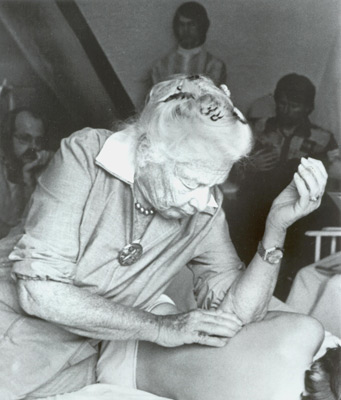
“Some individuals may perceive their losing fight with gravity as a sharp pain in their back, others as the unflattering contour of their body, others as constant fatigue, yet others as an unrelentingly threatening environment. Those over forty may call it old age. And yet all these signals may be pointing to a single problem so prominent in their own structure, as well as others, that it has been ignored: they are off balance, they are at war with gravity.”
Rolfing® Structural Integration…
takes a systematic approach to the body’s segmental relationships, through the manipulation of the fascia, over the course of ten sessions. The general goal is to bring head, neck, torso, pelvis, legs, and feet, into a balanced and supportive relationship with one another. Structural Integrations practitioners manually work with layers of fascia, repositioning and softening its hold on maladaptive patterns of strain. With newfound freedom, the body can reorganize itself into a more structurally harmonious relationship with gravity.
Lengthening and reorganizing the layers of fascia frees the body from patterns of tension and bracing, and restores mobility, alignment, and grace. As layers of fascial compensation patterns are freed, the body can reorganize itself.
Using hands and arms as tools, practitioners of Structural Integration move, layer by layer through the fascial web, helping dense fascia return to a healthy, pliable state. Muscles and joints can then function properly, allowing for flexibility and freedom of movement.
Ailments Relieved with Rolfing®
- Back Pain
- Frozen Shoulder
- Sciatica
- Flat Feet
- Plantar Fasciitis
- Migraines
- Scoliosis
- Tennis/Golfers Elbow
- Arthritis
- Neck-Upper Back Tension
- PTSD, ADD & ADHD
- TMJ, Temporal Mandibular Joint Disfunction
- Sway Back or Hunch Back
- Whiplash
- Carpal Tunnel Syndrome
Benefits of Rolfing®
- Improved balance
- Better posture
- Deeper, easier breathing
- Greater range of motion in joints
- Improved soft tissue flexibility
- More mental energy
- Decreased physical pain
- Easier recovery from exertion
- Fluid and easier movements
- Enhanced athletic performance
- Calmness of mind, a sense of well-being
- Improved body awareness
What is Fascia?
Fascia is everywhere. It connects by way of a multi-layered web-like system that wraps, surrounds and weaves through our entire bodies, from skin to bone and from head to toes. Its’ multifaceted role separates, connects, supports, balances, gives tension and gives compression allowing for movement while transferring loads equally. Fascia is the ground substance that all cells can imbed in making it possible for bone to be bone. Muscle to separate from other muscles. Fascia allows for layers to glide like silk ribbons over one another.
From the most superficial layer just beneath our skin to the deepest web penetrating our bones, fascia holds our cells, tissues and systems in place. Sometimes it is thin and wispy, sometimes it is thick and fibrous.
Fascia allows the many layers of muscles in our bodies to slide over each other, allowing for smooth uninhibited flexion and extension. Healthy fascia is pliable and hydrated, allowing muscles, tendons and ligaments to move freely and easily.
When fascia is stressed from injury, trauma or from postural habits and imbalanced repetitive movement, it becomes short, dense, and dehydrated, gluing muscles together and inhibiting movement. Shortened fascia compresses joints and puts stress on tendons and ligaments. This can result in injury and pain.
Fascia as an Organ of Form
Dr. Ida Rolf, the founder of Structural Integration, recognized that fascia is plastic in nature: it changes shape, and adapts to the way we use our bodies. When we move and stretch regularly, our fascia gets a work out, stays lubricated, allowing our muscles and the joints they control to function optimally. Likewise, when we are sedentary for long periods of time, our fascia shortens and hardens. We feel stiff, achy and exhausted.
Our Relationship with Gravity
The more aligned our structure is with the field of gravity, the less energy we expend on holding ourselves up. An aligned body moves with greater ease. It becomes more flexible and coordinated. It requires less energy to function. Good posture is effortless and breathing is easier. Athletic performance improves. Our reaction to stress decreases.
” A Rolfer™ works with gravity. He understands the gravitational pull in everything that a human being does, 24 hours a day, 365 days a year, from the moment he is conceived until the day the undertaker catches up with him. Gravity does not take a vacation.”